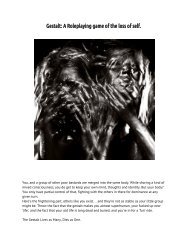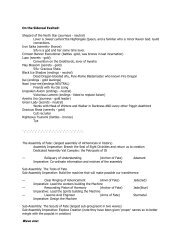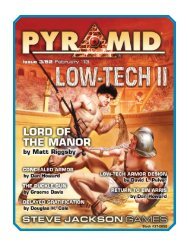13th Age - Foolz!
13th Age - Foolz!
13th Age - Foolz!
You also want an ePaper? Increase the reach of your titles
YUMPU automatically turns print PDFs into web optimized ePapers that Google loves.
information and opportunities that fall into your<br />
lap thanks to using your negative relationship<br />
need to help you have bigger and better<br />
confrontations with your enemy, rival, or jilted<br />
lover—however you choose to phrase the<br />
conflict!<br />
Often you might find that enemies of your<br />
rival see you as an opportunity to strike against<br />
that mutual enemy. You might get help, wealth<br />
and resources, and even magic items from quite<br />
unexpected sources, some of which may not be<br />
entirely to your liking. If you are a renowned<br />
enemy of the Diabolist, for example, you might<br />
get help from the Crusader or the Great Gold<br />
Wyrm. Choosing a negative relationship with a<br />
good or ambiguous icon is tantamount to asking<br />
for dramatic and unexpected twists to be thrown<br />
into your life . . . often.<br />
In addition to aid from others, icon<br />
relationships provide characters with special<br />
knowledge. For example, if the heroes are<br />
exploring an ancient graveyard, a player with<br />
any relationship to the Lich King, positive,<br />
conflicted, or negative, might be able to discern<br />
some important pattern or underlying structure<br />
of the tombs that the group wants to know more<br />
about, or that will help the group achieve their<br />
goal.<br />
A negative relationship with a thoroughly<br />
villainous icon is more in keeping with the<br />
heroic lifestyle, but you should expect that the<br />
assistance you get from a negative relationship<br />
may end up being more directly confrontational<br />
than more conventional conflicted and positive<br />
relationships. If you are a player who likes to<br />
choose negative relationships with the icons,<br />
you must want conflict. And you’ll get it.<br />
Remember, when you assign dice to a<br />
relationship, you are the one deciding how<br />
useful this relationship is going to be. Back that<br />
up by being creative with how your relationship<br />
applies to events in the game. Negative<br />
relationships just require more work to make<br />
sense of.<br />
Changing Relationships<br />
When your character achieves champion level<br />
(5th), you gain an extra relationship point. Use it<br />
to increase an existing relationship by one die or<br />
gain a 1-point relationship with a new icon to<br />
match your character’s story thus far. You can’t<br />
break the relationship point limit maximum<br />
(yet). Of course, you can save the extra<br />
relationship die and decide to apply it later,<br />
when there’s a dramatic campaign event or a<br />
solid story reason for it.<br />
At 5th level, or any time thereafter, you can<br />
switch an existing relationship point from one<br />
icon to another, including to a new icon. You<br />
owe the GM and other players an entertaining<br />
explanation of what this big change represents<br />
for your character personally, of course.<br />
When you reach epic level (8 th ), you gain<br />
another relationship point, which you can use to<br />
increase an existing icon relationship by one die,<br />
including up to 1 point over maximum. As at 5 th<br />
level, if switching a relationship point from one<br />
icon to another makes sense for your 8 th level<br />
character, go for it.<br />
<br />
Gamemaster<br />
Rules and suggestions for using icon<br />
relationships in play start on page XX.<br />
<br />
BACKGROUNDS & SKILL<br />
CHECKS<br />
Selecting your backgrounds is one of the fun<br />
parts of character creation where you get to<br />
make up story elements to add to the game.<br />
Each background is a piece of your character’s<br />
history that contributes to your character’s<br />
ability to succeed with non-combat skills.<br />
Instead of assigning points to skills as with<br />
other d20 games, in 13 th <strong>Age</strong> you assign a certain<br />
number of points (varying by class) to<br />
backgrounds. With backgrounds, you still<br />
choose how to allocate a certain number of<br />
points that function as bonuses to d20 skill rolls.<br />
But these points aren’t pegged to individual<br />
skills. Instead you put them into backgrounds,<br />
which are broad categories of experience (cat<br />
burglar, for example) rather than specific<br />
© 2012 Fire Opal Media. All rights reserved. 46







